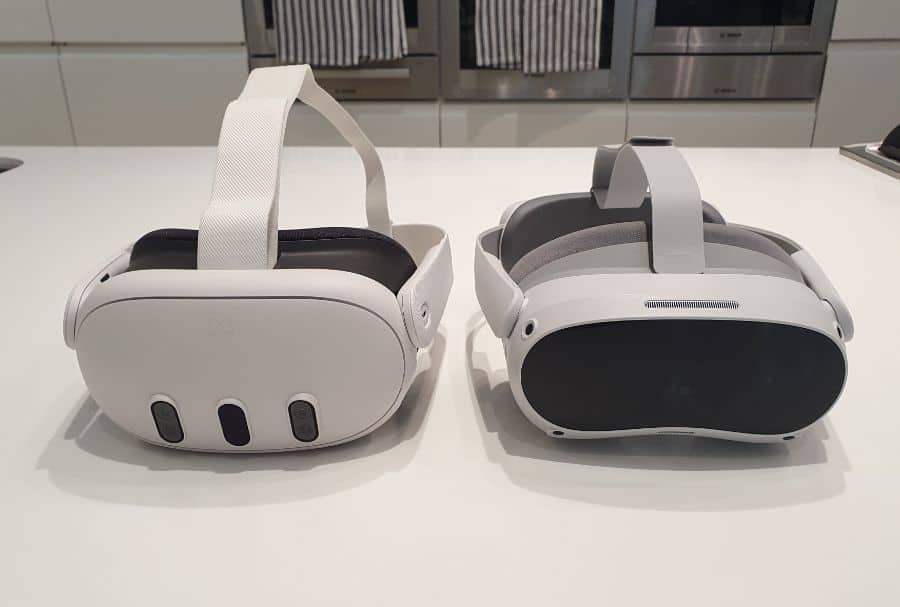
Virtual reality has come a long way in recent years, and standalone headsets are becoming increasingly impressive and capable. Two of the most popular standalone VR headsets on the market right now are the Meta Quest 3 and Pico 4. I’ve owned both headsets since the day they were released, and this article is going to share my experience and help you decide which headset is right for you.
Both the Meta Quest 3 and Pico 4 are standalone VR headsets, capable of providing immersive VR experiences without any additional hardware. In addition, they can both be connected to a VR-ready PC, either wirelessly or by USB-C cable, allowing you to play PC VR content on these headsets.
Quest 3 Vs Pico 4 Specifications
The Pico 4 was launched in October 2022 and has impressively clear pancake lenses, dual-LCD panels with 2160×2160 pixels per eye, and an impressive 104° horizontal FOV. The Quest 3 was released in October 2023 and has similar pancake lenses, a resolution of 2064×2208 per eye, 110° horizontal FOV, and contains the more powerful XR2 Gen2 processor, but costs a fair bit more to purchase.
The Quest 3 has a more mature software ecosystem with more games and apps available on the Quest/Oculus store compared to the Pico store. In addition, Quest 3 has much better MR capabilities and a growing number of mixed-reality games and experiences that are not possible on Pico 4.
Both headsets have advantages and disadvantages, but both headsets will appeal to different users. Hopefully, this article should be able to help you decide which is best for you. Here are the stats of the headsets in a bit more detail.
| Quest 3 | Pico 4 | |
| Launch | October 10, 2023 | October 18, 2022 |
| Lens Type | Pancake | Pancake lenses |
| Field of View | 110° horizontal, 96° vertical | 104° horizontal, 103° vertical |
| IPD Range | 53–75mm | 58-72 mm |
| Depth Adjustment | Yes | No |
| Display Type | Dual LCD | Dual LCD |
| Pixels Per Eye | 2064×2208 per eye | 2160×2160 per-eye |
| Pixels Per Degree (PPD) | 25 PPD | 20.6 PPD |
| Local Dimming | No | No |
| Max Refresh Rate | 120Hz (experimental) | 90Hz |
| Chipset | Snapdragon XR2 Gen 2 (4nm) | Snapdragon XR2 Gen 1 |
| RAM | 8GB | 8 GB |
| 6GHz Wi-Fi | Yes | No |
| Passthrough | True Color High Res | 16MP RGB camera |
| Battery Location | Visor | Back of headstrap |
| Battery Life | 2.2 hours (average) | 3 hours |
| Eye Tracking | No | No |
| Face Tracking | No | No |
| Controllers | Touch Plus Ringless TruTouch Haptics | 2 x Pico 4 Controller 6 DoF |
| Price | 128GB ($499.99 / £479.99) 512GB ($649.99 / £619.99) | 128GB £349 (€429) 256GB £419 (€499) |
Meta Quest 3 Vs Pico 4 Video Review
In addition to this written article, I’ve made an in-depth video covering my experiences using the Pico 4 and Meta Quest 3. I cover all the features and pros and cons that I have found after using both headsets for hundreds of hours.
Visuals And Displays
Having used both headsets extensively, there isn’t much to choose between the visuals of the Pico 4 and Quest 3. Both provide impressively clear visual clarity thanks to the combination of pancake lenses, high-resolution displays, and FOVs that take a step forward compared to older VR headsets such as the Quest 2 and HP Reverb G2.
Technically, the Quest 3 offers a slightly higher level of peak clarity of 25 PPD (pixels per degree) of resolution in the center of your vision compared to 20.6 PPD for the Pico 4. In reality, the difference is very marginal, and both headsets are broadly comparable.
Both headsets use LCD panels, which offer a lot of advantages but also share the downsides of LCD panels, most notably the inability to display truly black colors. Some people find this more distracting than others, particularly those who enjoy playing games with a lot of darkness, such as Elite Dangerous.
There are good reasons why many manufacturers have opted for LCD panels in preference to OLED, most notably the difficulty of producing high resolution, lol persistence, and high refresh rate OLED panels. Personally, I’ve been really impressed with the panels in both the Quest 3 and Pico 4, and feel that the trade-offs in the choice of technology have been the right ones.
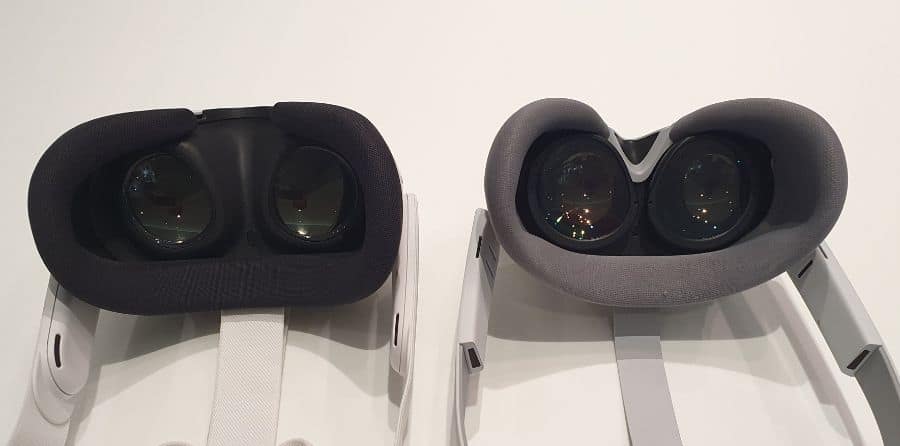
Software Ecosystem
Before you make a choice between the Meta Quest 3 and Pico 4, you need to know that the Quest ecosystem is much more mature and polished than the Pico ecosystem. This means smoother performance, fewer bugs, and a much larger and broader range of games and apps.
Whilst Pico is improving rapidly, and their progress over the last year has been generally impressive, they still lag behind Meta in this department. There are an increasing number of games that are available on both headsets, but there are still some important games that are only available on Meta headsets, such as Golf+, Resident Evil 4, and the upcoming Asgard’s Wrath 2 and Assassin’s Creed: Nexus.
PCVR With Pico 4 And Quest 3
Whilst Quest 3 has better standalone games and performance, things are much more even when it comes to PC VR content. Both headsets are able to connect to a VR-Ready PC, either wirelessly or via USB-C cable. Both have native connection options that work well, but you can also use the ever-popular Virtual Desktop with both Quest 3 and Pico 4.
Virtual Desktop performance is very similar between both headsets and it allows you to play all your favorite PC VR content wirelessly with good visual quality and low latency. Whilst the Quest 3 has a more powerful onboard processor, this really has negligible impact on PC VR performance, and I have played hundreds of hours of wireless content with Pico 4 over the last year with minimal issues.
More recently, I have been using the Quest 3 extensively with both a wired and wireless connection, and the performance is so good for most games, that I start to wonder what the future holds for dedicated wired PC VR headsets.
Head Strap And Comfort
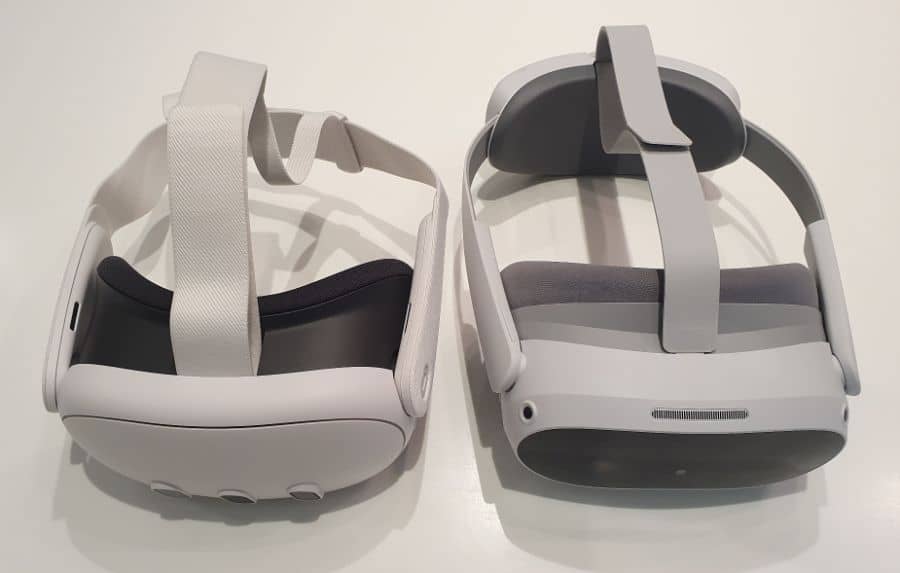
The Quest 3 comes with a fabric head strap that is mediocre at best, and shares many of the deficiencies that were apparent with the Quest 2 head strap. The Quest 3, whilst not lighter than the Quest 2, is much more compact, and the weight of the headset is positioned closer to your face when you wear it, making it feel a bit lighter.
However, it still has a tendency to wobble on your face when you make sudden movements, and it feels very front-heavy. As a result, the Quest 3 starts to get uncomfortable to wear after about an hour of use.
In contrast, the Pico 4 comes with a rigid strap that is reminiscent of the Quest 2 Elite Strap, and the battery is situated in this headstrap, providing a counterbalance to the weight of the headset. As a result, the Pico 4 is much more comfortable to wear, feeling much lighter and more secure to wear and use.
The downside to this is that you can’t change the head strap on the Pico 4, as the battery is hardwired into the head strap, so if you don’t like it, you’re stuck.
Despite the Pico 4 headstrap being a great success, I don’t find the facial interface to be very comfortable or to fit very well. There is a bit of light leak at each side when I wear it, and it can get a little uncomfortable to wear after an hour or two. It’s nothing that would stop me from playing, but I do think they can and should do better.
The advantage of the Quest 3’s head strap solution is that it keeps the cost of the headset down, but also allows you to change it for a more comfortable option, either the official elite battery strap or another 3rd party option, of which there is an increasingly large selection.
I have tried the official Quest 3 Elite Battery Strap and also a few 3rd party solutions, so there is likely to be a good option available for every user.
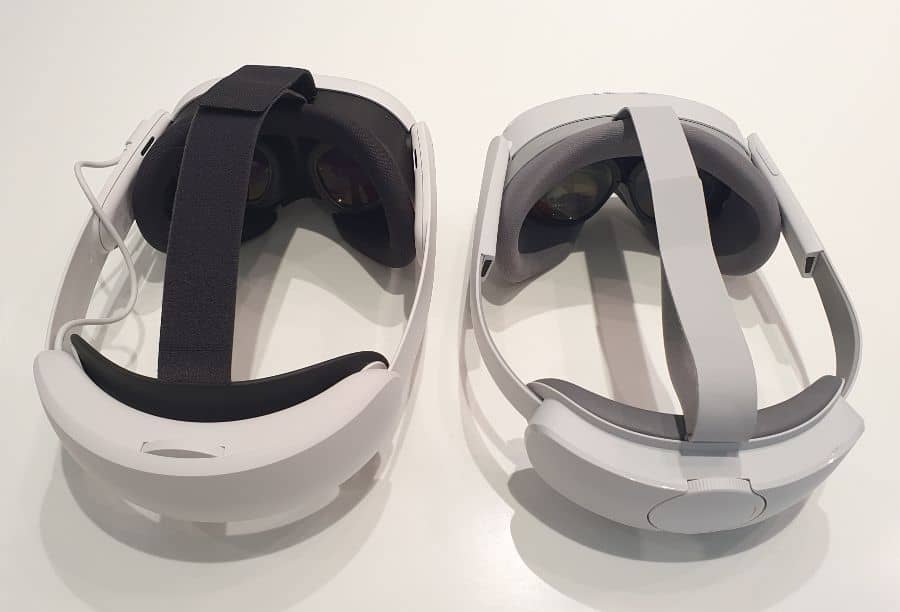
Mixed Reality
Pico 4 has RGB passthrough, but there is quite a lot of distortion, and the clarity is not sufficient to read a computer monitor or phone without difficulty. It provides a huge step up on the grayscale passthrough of the Quest 2, but pales in comparison to the Quest 3 passthrough.
The Pico 4 passthrough is highly welcome, and I use it to be able to navigate around my room without having to take the headset off, but due to the limited quality and lack of depth sensor, it has limited utility for me beyond this.
The Quest 3 was marketed as both a VR and MR headset, and I’ve been genuinely impressed with the quality and versatility of the MR experience. There are an increasing number of impressive MR games and apps such as PianoVision, Bam, Demeo, and MR updates to loads of popular games such as Eleven Table Tennis and Thrill Of The Fight.
The MR quality is good enough to read your phone or a computer monitor, but also has quite a lot of distortion, particularly when viewing things close up. I’ve been particularly impressed by the ability to use one or more virtual screens in MR to be genuinely productive when using my Quest 3.
I have experimented with writing and editing articles in mixed reality, using virtual monitors and voice typing, and this has worked surprisingly well. I’ve also been able to pull up a giant screen in front of me when I sit on the sofa, allowing me to watch Netflix and Amazon Video. I even pulled up a virtual screen in front of my treadmill while I went for a quick jog, although this was definitely just for a bit of fun, rather than something that was either comfortable or recommended.
Controllers And Tracking
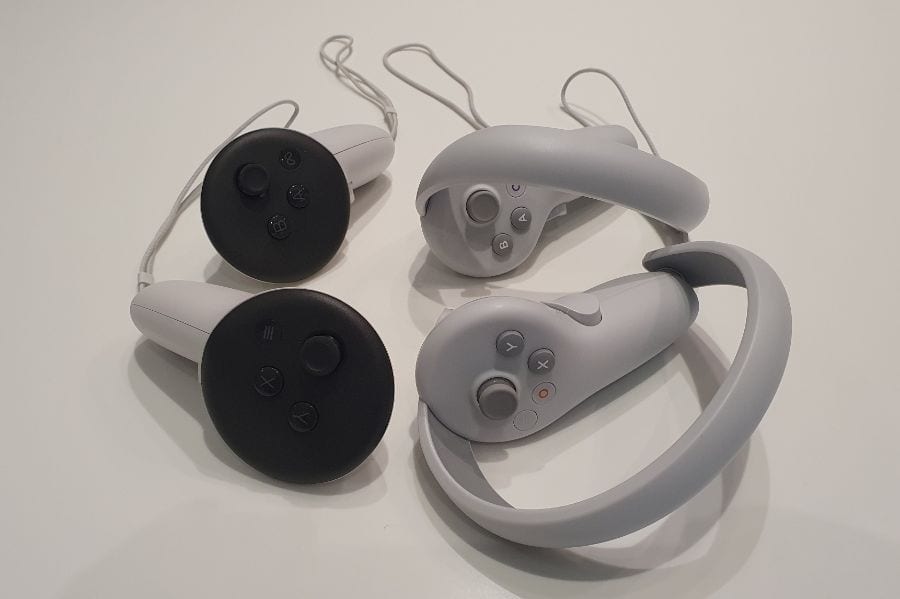
The new Touch Plus controllers of the Quest 3 are really impressive, providing excellent tracking performance that is a small but significant step up compared to Quest 2. The new ringless design makes them much more compact, and they feel great to use.
The Pico 4 controllers are also really well-designed controllers, and tracking performance is almost, but not quite as good as the Quest 3. I prefer the design, button positions, and compact nature of the Quest 3 controllers, but I honestly don’t have too many complaints about the Pico 4 tracking performance.
There is no doubt that external tracking is still a more precise option, but as far as standalone headsets and inside-out tracking go, I think both Quest 3 and Pico 4 are very impressive.
Both the Pico 4 and Quest 3 use AA batteries to power their controllers. The Pico 4 has a removable battery tray that requires two AA batteries, whereas the Quest 3 has an easily removable battery cover and requires one AA battery. As a result, the Pico 4 controllers are heavier than the Quest 3 controllers, but I don’t feel this has any major impact on their usability.
Performance
The Quest 3 uses the considerably more powerful Qualcomm Snapdragon XR2 Gen 2 processor, which is reported to have approximately twice the processing power of the XR2 Gen 1 processor that is found in the Pico 4. As a result, most games on Quest 3 have received a very noticeable and welcome jump in graphical quality, but in terms of gameplay, there is no significant difference between the same game played on Pico 4 and Quest 3.
One area where the processing power of the Quest 3 has a small advantage is in the latency experienced when wirelessly streaming to a VR-ready PC. The more powerful processor is able to process each frame about 10ms quicker according to my testing, leading to a very small improvement in latency when playing streamed content. Realistically, this only has an impact when playing games requiring the quickest reaction times.
Meta Quest 3 Vs Pico 4 Design
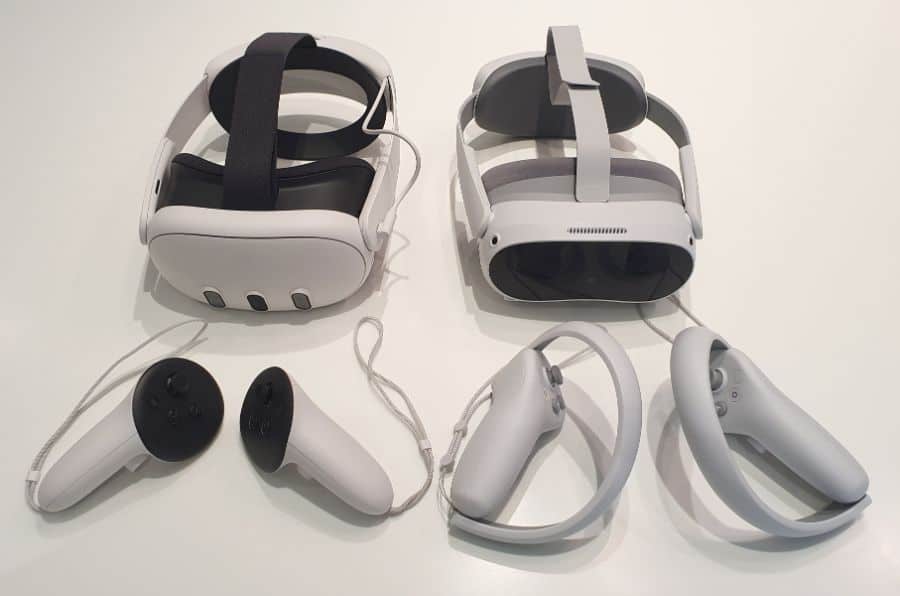
The Pico 4 is a really well-designed headset and I love the integrated head strap with the battery positioned at the back. The black, glossy front looks awesome and the compact design looks and feels great to hold and use. Other than the facial interface, which doesn’t fit my face terribly well, I wouldn’t change much about the design of the Pico 4.
The Quest 3 is also a big step up in the design department from the Quest 2, and the sleeker form factor looks awesome. My big criticism is that the default head strap provides very poor ergonomics, and almost everyone who intends to use their Quest 3 on a regular basis should update the head strap as soon as possible.
As a result of Meta’s design decisions, you should really factor in the cost of a better headstrap when comparing the price of these two headsets, making the difference in price much more marked, and this may be sufficient for some people to opt for the Pico 4 in preference to the Quest 3.
Battery Life
Both the Pico 4 and Quest 3 have battery lives of about 2-3 hours, depending on the activity being undertaken. The Pico 4 has a much larger battery but uses the less power-efficient XR2 Gen 1 processor, so has a greater power draw, resulting in battery life that is broadly compatible with the Quest 3.
Neither has a battery life that feels quite long enough, but there are a range of external battery solutions that can significantly lengthen the battery life of both headsets. This is one area where the replaceable head strap on the Quest 3 is an advantage, as battery head straps are generally one of the best options to boost battery life for this type of headset.
You’re not out of luck with the Pico 4 though, as you can use a variety of other external battery solutions such as side-mounted, neck hanging, or rear-mounted additional batteries.
Whatever way you look at it, if you end up using your Pico 4 or Quest 3 regularly and for long periods, you will definitely want to look at the options for battery extension.
Content Availability On Quest 3 And Pico 4
The Pico 4 had quite a limited selection of games and apps at launch, but the amount of content available on the platform has increased rapidly, and the Pico platform definitely has more than enough content to keep you entertained. This is even before considering the options for PCVR.
With that said, if you want the most complete library of content available for a standalone headset, then Meta’s software catalog is really impressive.
You do need to bear in mind with both headsets, that you are buying into closed ecosystems, and you can’t transfer purchases from the Pico to the Meta platform, or across to Steam if you decide to buy a headset from a different manufacturer in the future.
It looks like a safe bet that Meta is going to stay in the VR game, so I feel more confident buying my software from their store. Pico is newer and less established in the industry, and who knows what will happen in the future. It would be highly frustrating to lose access to software purchases in the future for any reason.
Depending on the game, it’s still my preference to purchase games on Steam and play via a wireless connection to a VR-ready PC. As Steam will work with any headset that is compatible with Steam, it gives you more flexibility. The downside is that games requiring precision timing or twitch reflexes suffer from some latency, which can impact your performance.
Price And Value
Although the Quest 3 is the more expensive headset, I think it offers an excellent value proposition, due to the impressive hardware specs, excellent content library, mixed reality content, and the ability to play PC VR content too. The Pico 4 has a number of drawbacks, but some people will find that the price more than compensates for these, depending on what they intend to use the headset for.
Who Should Buy The Quest 3?
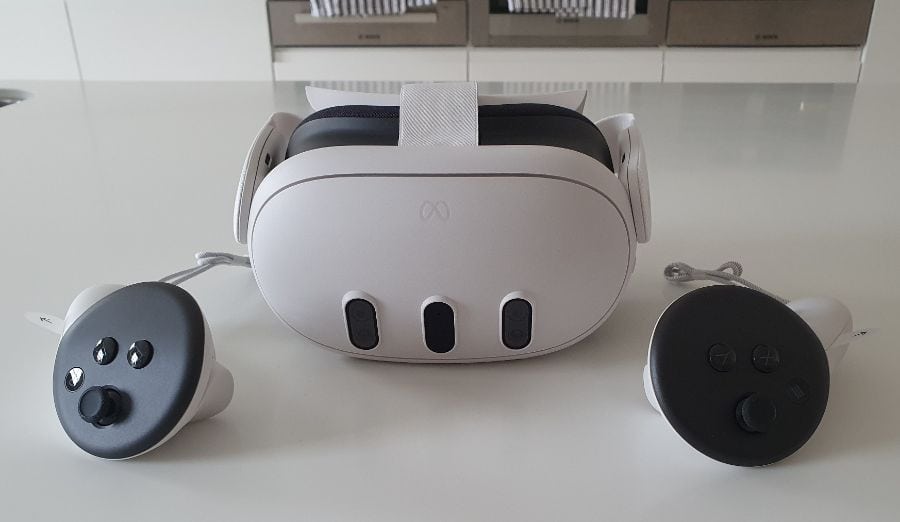
If price is not a major factor, then I would highly recommend choosing the Quest 3. In terms of hardware and software, it is a better headset than Pico 4, and I have found the software and hardware performance to be superior and worth the extra cost.
Mixed Reality opens the door to a wealth of new experiences and gameplay options, and although the technology is still relatively immature, it is very impressive nonetheless. Learning to play the piano with PianoVision, challenging friends to a game of Bam in mixed reality, or pulling up a big virtual screen in my real-life room feels like the future.
Meta has committed to driving VR and MR technology forward, targeting mainstream consumers, and all indications are that they are in it for the long haul.
If you are looking to buy your first VR headset, the Meta Quest 3 is definitely the one that most people should choose. I’ve had a blast using it, and I have no doubt that it will be the headset I use the most out of all the ones I own for quite some time to come.
If you are looking to upgrade to the Quest 3, the decision is more nuanced. If you are a Quest 2 user, you can achieve much the same VR experience as the Quest 3, albeit with less impressive graphics. Although the lenses, screen resolution, and FOV aren’t as good, the Quest 2 still offers very reasonable performance.
If money is not the primary motivator, the upgrade is well worth it, but if finances are tight, you’re not missing that much by sticking with the Quest 2 for now.
Who Should Buy The Pico 4?
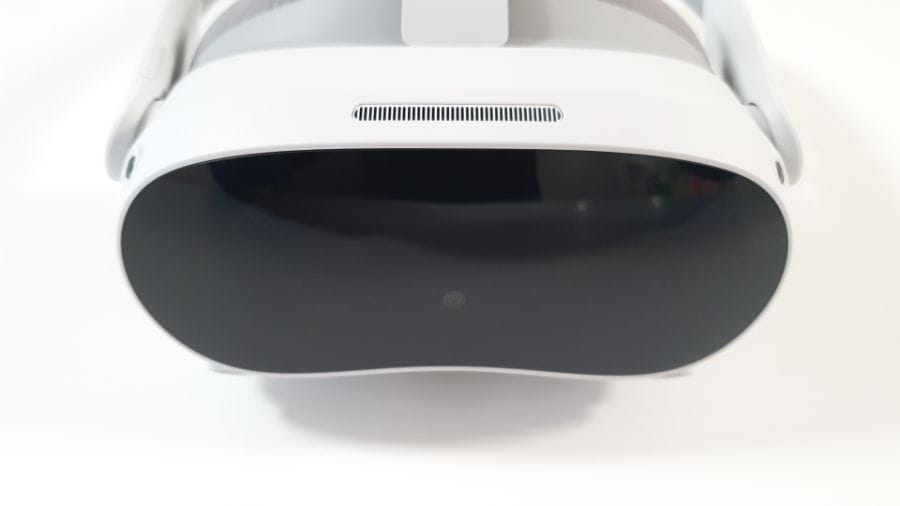
The main appeal of the Pico 4 in 2023/2024 is that it is a great headset at an awesome price. As a cost-effective way to get into VR, the Pico 4 is terrific.
If you’re looking for a good quality headset for PC VR that also performs well as a standalone VR headset, the Pico 4 offers tremendous value for money and is probably the better choice if PCVR is going to be your main focus and you want the best value headset.
As a standalone headset, it is increasingly impressive, with steady improvements to the UI, software, controller tracking, and variety of content. If you don’t have much interest in MR content, and you’re happy to forego the bump in graphical fidelity that comes with the Quest 3, then the Pico 4 is a great option.
I have used the Pico 4 for many hundreds of hours over the last year and I am confident that it is an excellent VR headset at a great price. The 128GB Quest 3 currently costs £130 more than the equivalent Pico 4, and you will need to buy a better head strap to really compare the two, which adds to the price difference.
Meta Quest 3 Vs Pico 4: The Bottom Line
The Meta Quest 3 is the newer, better headset in most ways, but it’s more expensive to buy. The Pico 4 matches the Quest 3 in terms of visual clarity, but lacks quality MR support, and has a less powerful processor. As for me, I’ll be using the Quest 3 in preference to the Pico 4 headset for the next while, but if I only had access to the Pico 4, I’d be very happy too.
